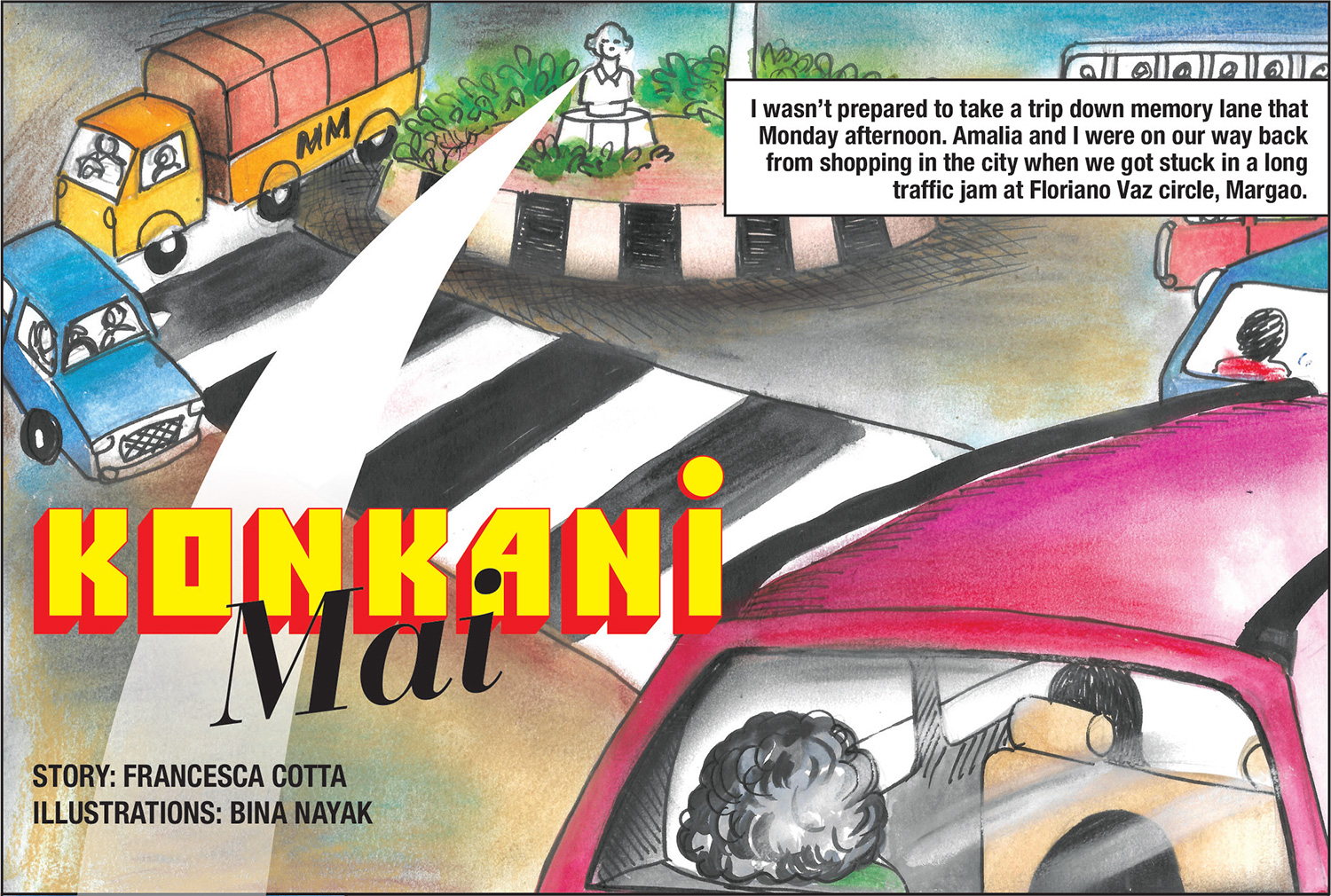
Vol 5 No 3 | Oct-Dec 2025
Konkani Mai
Story by Francesca Cotta | Art by Bina Nayak
Based on a true story…
From writer Francesca Cotta: This comic is inspired by real events that took place on 20 December, 1986. My parents were actually married on that day. The riots and escalating tensions on the streets created much uncertainty as to how the bridal entourage and guests would get to the wedding. Many invitees were unable to make it.
My father did have an accident because of oil thrown on the roads and sustained a couple of bruises. I’m not sure if they didn’t have telephones or there was a power outage in my father’s village of Agassaim, but my mother and her family only found out about the accident and how serious the protests had gotten once they met at the church.
I’ve always found this story fascinating for its connection to our local history. But I never investigated how deep the significance of the socio-political events that shaped this memorable day ran until recently.
Who was Floriano Vaz?
Floriano Vaz (8 September, 1963 – 20 December, 1986) was a Goan writer and activist who became a symbol of the struggle for the Konkani language’s official recognition in Goa. Born in Gogol, Margao, he belonged to a Scheduled Tribe community and actively participated in the Konkani language agitation, a mass movement that sought to secure official status for Konkani in the state. Floriano is commemorated as the first martyr of this movement, highlighting both his personal sacrifice and the broader social stakes of the agitation.
On 20 December 1986, during the language protests, in the midst of a confrontation stemming from language-political tensions, Vaz was shot in a dispute involving local authorities and a businessman. His death sparked widespread outrage and solidarity with the Konkani cause, intensifying the demand for linguistic justice.
Vaz’s legacy is preserved through tributes such as the bust installed at the Floriano Vaz Circle in Margao, a reminder of his role as both an individual martyr and a unifying symbol for the tribute to Konkani identity and rights.
http://mymargao.barretomiranda.com/floriano-vaz/
https://www.heraldgoa.in/goa/martyr-floriano-continues-to-drive-the-spirit-of-romi-konkani/441847/
Konkani language agitation of ‘86
The Konkani language agitation of 1986 was a turning point in Goa’s cultural history. After Goa became a state, there was a debate over whether Marathi or Konkani should be the official language. Many Goans feared that without recognition, their mother tongue Konkani, would slowly lose its place in education and public life.
Young people played a key role in the movement. College and high school students skipped classes to join rallies and street marches. They carried banners, shouted slogans, and wrote songs and plays in Konkani to inspire others. Youth groups organised sit-ins, hunger strikes, and cultural programs that spread awareness across villages and towns. Their energy gave the agitation its strength, and they became the voice of a new generation defending Goa’s identity.
But the protests were not always peaceful. Police tried to stop demonstrations, and clashes often turned violent. Many students and young activists were beaten or arrested. The darkest moment came in December 1986, when 23-year-old activist Floriano Vaz was shot dead. His martyrdom united the movement and inspired thousands to continue the struggle.
Finally, in 1987, the government passed the Official Language Act, giving Konkani in the Devanagari script official status. The agitation showed the power of Goa’s youth in shaping its future.
Konkani’s long struggle
For centuries, Konkani faced suppression despite being the mother tongue of most Goans. Under Portuguese colonial rule, the use of Konkani in schools, churches, and administration was discouraged, while Portuguese dominated official life. Many educated Goans turned to Marathi for literature, education, and religion, which led to the belief that Konkani was merely a dialect of Marathi. This created a long-lasting divide in Goa’s linguistic identity.
After Liberation in 1961, the struggle shifted to proving Konkani’s independence as a language. In 1975, the Sahitya Akademi recognised Konkani as an independent and literary language, yet debates continued. The 1986–87 agitation finally secured Konkani (but only in the Devanagari script) as Goa’s official language. However, tensions remain. Konkani is spoken in many dialects across Bardez, Salcete, and other regions,and written in both Roman (Romi) and Devanagari scripts. Supporters of Romi script, widely used in daily life by Goan Catholics and among the diaspora, still fight for equal status, keeping the language debate alive today.
https://sweetcom.in/2025/02/exploring-the-richness-of-konkani-language/
https://www.youtube.com/results?search_query=konkani+songs
Status of Romi Konkani today
Floriano Vaz is still remembered as a hero by many people in Goa. Today, his story inspires activists who are fighting to give equal respect to Konkani written in the Roman script (Romi Konkani). Groups like the Global Konknni Forum have met at his statue in Margao to honour him and to remind everyone that their fight for the recognition of Romi Konkani is far from over. They believe that Romi Konkani should have the same official status as the Devanagari script in schools and government. Activists say their goal is only fair, given that Romi Konkani is the language of daily life for thousands of Goans. Floriano’s sacrifice gives them courage to continue this struggle.
https://www.gomantaktimes.com/my-goa/art-culture/why-not-romi-konkani-ask-goas-language-campaigners
https://mumbaimirror.indiatimes.com/others/sunday-read/konkani-city/articleshow/124019545.html

